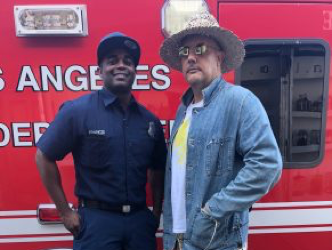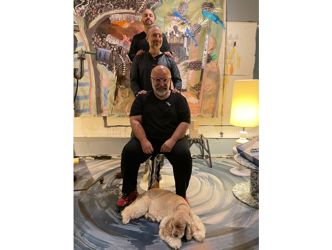Immortality
Without wanting to resort to big words, having your portrait done is a good way of attempting to achieve immortality. In New York it was Andy Warhol who, in the 1960s, brought the discipline back in fashion like no one else. But before him there was already another extraordinary person who shared this obsession consisting of imaging the world. She was called Alice Neel (1900-1984), she was born in Pennsylvania, and she had a passion for people in general and originals in particular.
Her New York circle

But in a much more artisanal fashion and against all commercial preoccupations, Alice would paint, throughout her life, her extensive New York circle. In France she has remained virtually unknown, in spite of a beautiful exhibition at the Van Gogh Foundation in 2017 in Arles. In Paris, the Centre Pompidou are making up for this gap by dedicating a part of their first floor to her until 16 January under the title “Alice Neel, un regard engagé” (Alice Neel: An Engaged Eye).
Angela Lampe
Overseen by the curator Angela Lampe, it sets itself apart from recent exhibitions at the Guggenheim Bilbao and the Metropolitan Museum with its political stance: “She wanted to share an intimacy with those who had been marginalized by American society, those who were side-lined due to their origins, the colour of their skin, their sexual orientation or their opinions”.
75 paintings
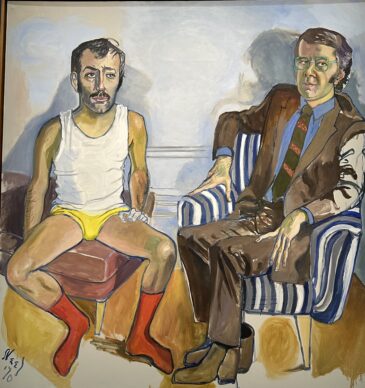
The exhibition comprises 75 paintings and we find here the majority of the major works from the exhibitions in New York and Bilbao, with the exception of her astonishing nude self-portrait made when she was in her 80s, which has not been loaned by Washington’s National Portrait Gallery.
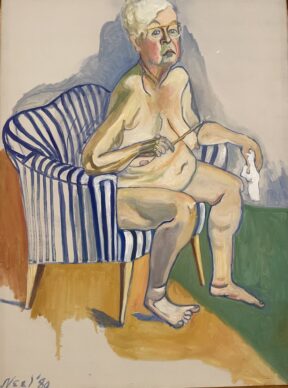
Alice Neel (not in the show)
But when we talk to people who knew her what we learn straight away is that she was a woman who was liberated, without the orthodoxy that is required today of ambassadors for LGBT+ rights or supporters of minority groups.
Robert Storr
Robert Storr, an eminent American art historian, met her in 1978 (See here the report about Robert Storr). “I think that she focused on the portrait because people in all their motliness and extravagance fascinated her. She thought of herself as being a census-taker akin to the itinerant protagonist of Gogol’s ‘Dead Souls’, except that her subjects were with one or two exceptions very much alive. She was a true bohemian. She was a liberated woman in a male dominated art world, a natural born anarchist and a fearlessly thorough observational ‘realist’.”
Supporter of communism
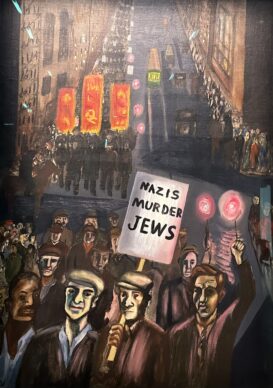
For Alice Neel, unique as she was, recognition would take a while. She had to wait until 1974 for New York’s Whitney Museum to stage an exhibition of her work. Throughout the post-war period her creations were overlooked. This is because she had several handicaps. Other than the fact that was she was a woman, and a liberated one at that, from 1935 she was a supporter of the communist party and voiced this openly. The witch hunt surrounding the senator Joseph McCarthy even caught up with her in 1953. At the Pompidou you can also see a work by Jenny Holzer (born in 1950) reproducing an FBI report from 1953 on the older artist which talks about the subject (See here a report about Jenny Holzer).
Michel Auder
Moreover, figurative art was not in fashion in the United States at the time. The memory left by Neel is, nonetheless, one of a figure who was cheerful, jovial, curious, even provocative. Michel Auder remembers, with amusement, how towards the end of her life at a dinner organized in Neel’s honour by the New York authorities she had shown her unique sense of hierarchy: “At the top table she had seated me close to the mayor, next to her framer and the former porn star Annie Sprinkle. Her family, Andy Warhol etc, were at another table.”
Robert Mapplethorpe

Robert Mapplethorpe
At the Centre Pompidou the great world of Alice Neel opens with a portrait taken of her by Robert Mapplethorpe, who at the time was one of the most sought-after portrait photographers in New York. It was taken the year of her death, in 1984. The old woman with a white chignon has her eyes closed and her mouth open, as though she’s holding her breath. A premonitory foreshadowing of her death.
The tonight show
It was also in 1984 that she made a television appearance on The Tonight Show hosted by comedian Johnny Carson. She comes across as playful and clearly delighted to have her fifteen minutes of fame. Here she also offers, in passing, one of the keys to her work: “I don’t like painting ordinary people. I like to paint people that have been through the rat race of life.”
Andy Warhol
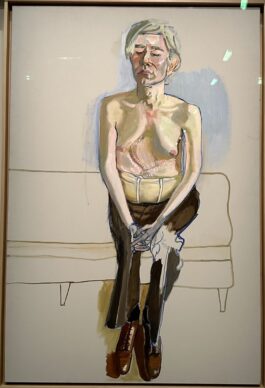
In the case of Andy Warhol, whose portrait she painted in 1970 on a large canvas measuring 1.5 metres tall, almost life size, she asked him to pose seated, with his torso bare. Not only is the king of portraitists being portrayed, so the tables are turned, but the viewer is also confronted with his suffering: enormous scars run across his stomach. Two years earlier he was attacked with a revolver by the delusional feminist Valerie Solanas.
It’s easy to see the painter’s technique in this portrait, which starts first with outlining the contours with bluish lines before filling in the interior of the composition.
Joe Gould
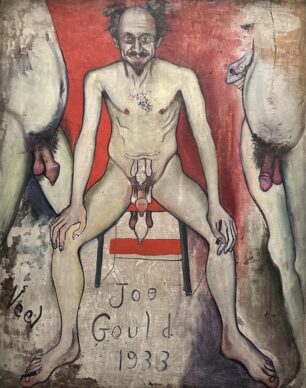
One of the most surprising canvases in the exhibition dates from 1933 and portrays Joe Gould, a half-writer half-beggar who was a fixture of Greenwich Village. He is depicted naked and smiling, his prominent genitals clearly on show, flanked by two profiles of naked men. In 1962 Neel talked to a journalist from the New Yorker about this painting: “I call it Joe Gould but I probably should call it ‘A Portrait of an Exhibitionist’. I’m sure that he wasn’t – technically. Still, to be perfectly honest, years ago, watching him at parties, I used to have a feeling that there was an old exhibitionist shut up inside him and trying to get out”.

In the main gallery of Alice’s portraits there are a number of African American, Latino and Afro-Caribbean intellectuals, but also the children of neighbouring families and nude pregnant women, a phenomenon that is unique in the history of art.
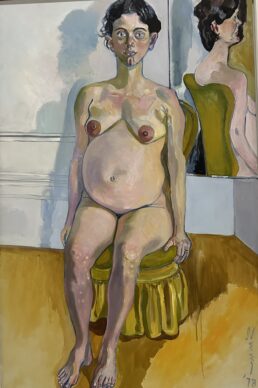
In an autobiographical book published a year before her death, Alice Neel explained her obsession: “People’s images reflect the era in a way that nothing else could. When portraits are good, they reflect the culture, the time and so many other things.”
Alice Neel. Un regard engagé. From 5 October to 16 January, www.centrepompidou.fr
Donating=Supporting

Support independent news on art.
Your contribution : Make a monthly commitment to support JB Reports or a one off contribution as and when you feel like it. Choose the option that suits you best.
Need to cancel a recurring donation? Please go here.
The donation is considered to be a subscription for a fee set by the donor and for a duration also set by the donor.


